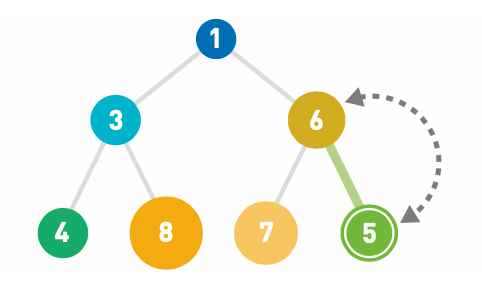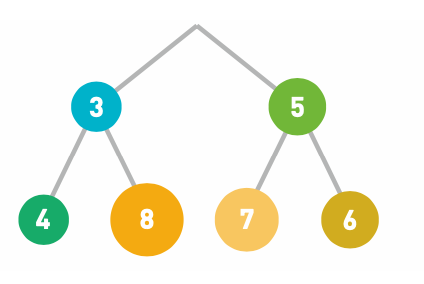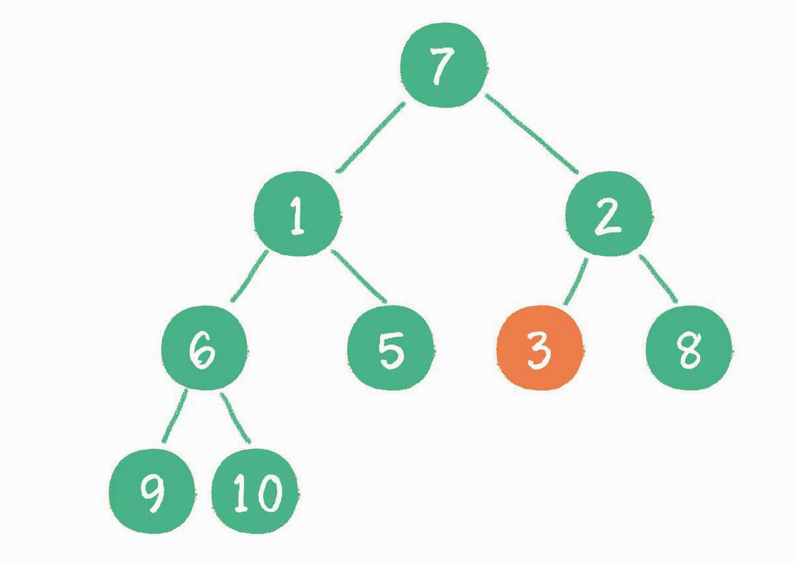堆排序
堆排序是利用堆这种数据结构而设计的一种排序算法,堆排序是一种选择排序,它的最坏,最好,平均时间复杂度均为 O(nlogn),它也是不稳定排序。
# 堆
二叉堆本质上是一种完全二叉树,它分为两个类型
大顶堆:每个结点的值都大于或等于其左右孩子结点的值
![-w430]()
小顶堆:每个结点的值都小于或等于其左右孩子结点的值
![-w409]()
二叉堆虽然是一个完全二叉树,但它的存储方式并不是链式存储,而是顺序存储;二叉堆的所有节点都存储在数组中。

- 大顶堆:arr[i] >= arr[2i+1] && arr[i] >= arr[2i+2]
- 小顶堆:arr[i] <= arr[2i+1] && arr[i] <= arr[2i+2]
# 自我调整
# 插入节点

1.往堆里添加数字 5。在堆中存储数据时必须遵守这样一条规则: 子结点必定大于父结点。因此,最小值被存储在顶端的根结点中。往堆中添加数据时,为了遵守这条规则,一般会把新数据放在最下面一行靠左的位置。当最下面一行里没有多余空间时,就再往下另起一行, 把数据加在这一行的最左端。

2.如果父结点大于子结点, 则小顶堆的规则,因此需要交换父子结点的位置

3.这里由于父结点的 6 大于子结点的 5,所以交 换了这两个数字。重复这样的操作直到数据都 符合规则,不再需要交换为止。

现在,父结点的 1 小于子结点的 5,父结点的数字更小,所以不再交换。
# 删除节点

将 1 从堆中移除

由于最上面的数据被取出,因此堆的结构也需 要重新调整。将最后的数据(此 处为 6)移动到最顶端。

如果子结点的数字小于父结点的,就将父结点 与其左右两个子结点中较小的一个进行交换

重复操作直到数据都符合规则,不再需要交换为止。

# 构建二叉堆
构建二叉堆,也就是把一个无序的完全二叉树调整为二叉堆,本质就是让所有非叶子节点依次“下沉”

从最后一个非叶子节点开始,也就是从节点 10 开始。如果节点 10 大于它左、右孩子节点中最小的一个,则节点 10“下沉”。

接下来轮到节点 3,如果节点 3 大于它左、右孩子节点中最小的一个,则节点 3“下沉”。

然后轮到节点 1,如果节点 1 大于它左、右孩子节点中最小的一个,则节点 1“下沉”。事实上节点 1 小于它的左、右孩子,所以不用改变。
接下来轮到节点 7,如果节点 7 大于它左、右孩子节点中最小的一个,则节点 7“下沉”。

节点 7 继续比较,继续“下沉“

经过上述几轮比较和“下沉”操作,最终每一节点都小于它的左、右孩子节点,一个无序的完全二叉树就被构建成了一个最小堆。
# 思想
将待排序序列构造成一个大顶堆,此时,整个序列的最大值就是堆顶的根节点。将其与末尾元素进行交换,此时末尾就为最大值。然后将剩余 n-1 个元素重新构造成一个堆,这样会得到 n 个元素的次小值。如此反复执行,便能得到一个有序序列了
# 代码
构建 Heap 结构
struct Heap<T> {
var nodes = [T]()
private var order: (T, T) -> Bool
init(order: @escaping (T, T) -> Bool) {
self.order = order
}
init(array: [T], order: @escaping (T, T) -> Bool) {
self.order = order
configureHeap(from: array)
}
private mutating func configureHeap(from array: [T]) {
nodes = array
/// 从最后一个非叶子节点开始,依次做“下沉”调整, (n/2 - 1) 或者 (n/2 - 3/2) , 向下取整,所以都是 n/2 - 1
for i in stride(from: nodes.count/2 - 1, to: 0, by: -1) {
shiftDown(i)
}
}
var isEmpty: Bool {
return nodes.isEmpty
}
var count: Int {
return nodes.count
}
@inline(__always) internal func parentIndex(ofIndex i: Int) -> Int {
return (i - 1) / 2
}
@inline(__always) internal func leftChildIndex(ofIndex i: Int) -> Int {
return 2 * i + 1
}
@inline(__always) internal func rightChildIndex(ofIndex i: Int) -> Int {
return 2 * i + 2
}
func peek() -> T? {
return nodes.first
}
mutating func insert(_ value: T) {
nodes.append(value)
shiftUp(nodes.count - 1)
}
mutating func replace(index i: Int, value: T) {
guard i < nodes.count else {
return
}
remove(at: i)
insert(value)
}
mutating func remove(at index: Int) -> T? {
guard index < nodes.count else { return nil }
let size = nodes.count - 1
if index != size {
nodes.swapAt(index, size)
shiftDown(from: index, until: size)
shiftUp(index)
}
return nodes.removeLast()
}
mutating func shiftUp(_ index: Int) {
var childIndex = index
let child = nodes[childIndex]
var parentIndex = self.parentIndex(ofIndex: childIndex)
while childIndex > 0 && order(child, nodes[parentIndex]) {
nodes[childIndex] = nodes[parentIndex]
childIndex = parentIndex
parentIndex = self.parentIndex(ofIndex: childIndex)
}
nodes[childIndex] = child
}
mutating func shiftDown(from index: Int, until endIndex: Int) {
let leftChildIndex = self.leftChildIndex(ofIndex: index)
let rightChildIndex = leftChildIndex + 1
var first = index
/// 左节点
if leftChildIndex < endIndex && order(nodes[leftChildIndex], nodes[first]) {
first = leftChildIndex
}
/// 右节点
if rightChildIndex < endIndex && order(nodes[rightChildIndex], nodes[first]) {
first = rightChildIndex
}
if first == index { return }
/// 调整
nodes.swapAt(index, first)
shiftDown(from: first, until: endIndex)
}
mutating func shiftDown(_ index: Int) {
shiftDown(from: index, until: nodes.count)
}
}
以下是在 Swift 中实现堆排序的方法:
extension Heap {
public mutating func sort() -> [T] {
for i in stride(from: (elements.count - 1), through: 1, by: -1) {
swap(&elements[0], &elements[i])
shiftDown(0, heapSize: i)
}
return elements
}
}
为堆实现添加了一个sort()函数。 这个函数的使用方式:
var h1 = Heap(array: [5, 13, 2, 25, 7, 17, 20, 8, 4], sort: >)
let a1 = h1.sort()
因为我们需要一个max-heap来从低到高排序,你需要给Heap提供 sort 函数的反向排序。 要对<进行排序,必须使用>作为 sort 函数创建Heap对象。 换句话说,从低到高的排序会创建一个 max-heap 并将其转换为 min-heap( 译注: 这边的意思就是排完序以后就变成了一个从小到大的特殊的 min-heap)。
我们可以为此编写一个方便的辅助函数:
public func heapsort<T>(_ a: [T], _ sort: @escaping (T, T) -> Bool) -> [T] {
let reverseOrder = { i1, i2 in sort(i2, i1) }
var h = Heap(array: a, sort: reverseOrder)
return h.sort()
}
使用方式:
let a2 = heapsort([5, 13, 2, 25, 7, 17, 20, 8, 4], <)
print(a2)


